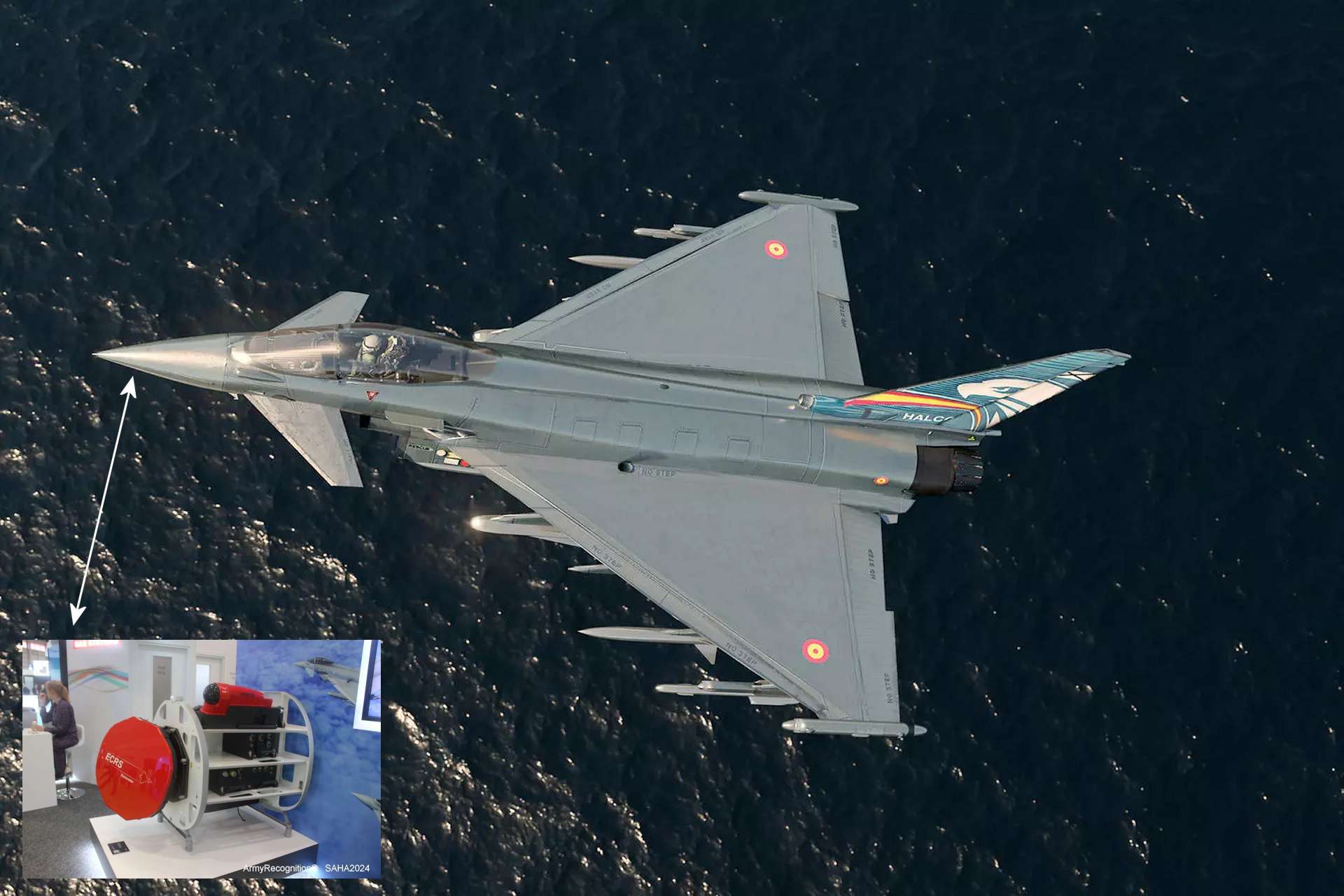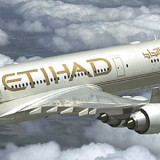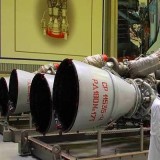Airbus Improves Spanish Eurofighter Fleet Capabilities with Advanced Captor-E Mk 1 Radar

{loadposition bannertop}
{loadposition sidebarpub}
Airbus has officially begun flight tests of the Eurofighter Typhoon equipped with the Captor-E radar featuring an active electronically scanned array (AESA) antenna. These tests, conducted in Spain, are part of the Spanish Air Force’s Halcon program, a modernization initiative that includes the acquisition of 20 new Eurofighter Typhoons built to the advanced Tranche 4 standard. This program represents a significant enhancement of Spain’s aerial combat capabilities through the integration of cutting-edge radar technology.
Follow Army Recognition on Google News at this link
Spanish Eurofighter Typhoon equipped with the Captor-E Mk1 AESA radar. (Picture source: Airbus and Army Recognition)
The Captor-E Mk 1 radar, recognized as one of the most advanced systems in Western defense, is a key feature of these new aircraft and will also be retrofitted onto at least five Tranche 3A Eurofighters as part of the Spanish fleet upgrade. Beyond Spain, this radar plays a central role in Germany’s Quadriga program, supporting the new Tranche 4 Eurofighters for the Luftwaffe and upgrading Tranche 2 and 3A models. Its widespread adoption underscores the transformative impact of this radar on multi-role combat platforms, offering long-range detection and simultaneous tracking of multiple aerial targets.
The Captor-E enhances the Eurofighter’s battlefield versatility by combining AESA capabilities with the PIRATE electro-optical system, optimizing situational awareness and strike precision. While the Mk 1 radar is operational, the development of the Mk 2 variant is already underway, with the UK planning its deployment on its own Eurofighter fleet. The Mk 2 aims to further boost the platform’s competitiveness and ensure its relevance in evolving combat scenarios.
With these advancements, the Eurofighter Typhoon continues to evolve, reflecting Airbus and its partner nations’ commitment to maintaining an interoperable, cutting-edge combat platform. Thanks to its advanced radar and sensor suite, the Eurofighter stands as a formidable asset for NATO and allied air forces, prepared to meet the challenges of modern aerial warfare.
The Captor-E radar’s development has been a collaborative effort initiated in the 2000s by the Euroradar consortium, which includes Leonardo, Hensoldt, and Indra. This AESA radar represents a major technological breakthrough, achieving operational maturity in the early 2020s. It provides enhanced long-range detection, simultaneous multi-target tracking, and a scalable architecture for regular updates to meet modern conflict requirements.
In 2022, Spain formally announced its intent to equip its 20 new Tranche 4 Eurofighter Typhoons with the Captor-E Mk 1 as part of the Halcon program, with initial deliveries expected by 2025. The radar will also be retrofitted into at least five Tranche 3A aircraft already in service, with upgrades beginning in 2024. This modernization effort, set to be fully operational by 2027, aims to enhance the Spanish Air Force’s air superiority and multi-role capabilities while ensuring compatibility with NATO’s future technological standards, thereby securing the long-term viability of Spain’s air forces against strategic challenges in the coming decades.
The first flight tests of the Captor-E on Spanish Eurofighters began in 2024 in Spain, marking a crucial step toward the operational deployment of these advanced aircraft. The integration of this radar, paired with the PIRATE system for electro-optical operations, positions Spain among Europe’s best-equipped air forces. Combined with similar initiatives in Germany and the UK, it highlights a concerted effort to maintain the Typhoon’s relevance and competitiveness against modern aerial threats.
The Captor-E has already been integrated into other Eurofighter Typhoons, particularly as part of modernization programs for German and British air forces, as well as for newly ordered aircraft. In Germany, this radar equips 38 Tranche 4 Eurofighters under the Quadriga program, which replaces older Tranche 1 models in the Luftwaffe. These aircraft benefit from the Mk 1 variant of the Captor-E, significantly enhancing their multi-role combat capabilities, particularly in air superiority and strategic interdiction missions.
In the UK, an even more advanced version, the Captor-E Mk 2, is under development for the British Eurofighter Typhoon fleet. This version will include enhanced features such as expanded electronic warfare capabilities and sophisticated countermeasures, making these aircraft even more effective in contested environments. Other Eurofighter operators, such as Italy and Saudi Arabia, also plan to integrate the Captor-E radar into their fleets during future upgrades. To date, this radar remains exclusive to the Eurofighter, though its architecture could be adapted for other platforms if necessary, albeit with significant modifications.
The Captor-E radar was designed to deliver technological superiority in modern aerial combat missions, thanks to its advanced detection and tracking capabilities. Featuring an AESA antenna mounted on a rotating platform, it offers an extended field of view of 200 degrees, compared to approximately 120 degrees for traditional fixed AESA radars. Capable of detecting targets at distances exceeding 370 km, it can simultaneously track up to 40 aerial targets while guiding multiple missiles. These performance capabilities enable optimal management of multiple threats during complex air-to-air engagements.
Additionally, its electronic warfare capabilities allow it to jam enemy systems over hundreds of kilometers and gather intelligence on adversary radar emissions. This multi-role radar was developed for a wide range of missions, from air superiority to precision ground strikes, making it especially suitable for complex operations requiring heightened situational awareness. With extremely fast data refresh rates and transmission power that can penetrate advanced electronic countermeasures, the Captor-E ensures reliable performance in critical operations. When combined with the PIRATE system for infrared imaging, it provides the Eurofighter with unmatched capabilities for advanced reconnaissance, strategic interdiction, and air defense missions, solidifying its position among the world’s leading multi-role fighters.

{loadposition bannertop}
{loadposition sidebarpub}
Airbus has officially begun flight tests of the Eurofighter Typhoon equipped with the Captor-E radar featuring an active electronically scanned array (AESA) antenna. These tests, conducted in Spain, are part of the Spanish Air Force’s Halcon program, a modernization initiative that includes the acquisition of 20 new Eurofighter Typhoons built to the advanced Tranche 4 standard. This program represents a significant enhancement of Spain’s aerial combat capabilities through the integration of cutting-edge radar technology.
Spanish Eurofighter Typhoon equipped with the Captor-E Mk1 AESA radar. (Picture source: Airbus and Army Recognition)
The Captor-E Mk 1 radar, recognized as one of the most advanced systems in Western defense, is a key feature of these new aircraft and will also be retrofitted onto at least five Tranche 3A Eurofighters as part of the Spanish fleet upgrade. Beyond Spain, this radar plays a central role in Germany’s Quadriga program, supporting the new Tranche 4 Eurofighters for the Luftwaffe and upgrading Tranche 2 and 3A models. Its widespread adoption underscores the transformative impact of this radar on multi-role combat platforms, offering long-range detection and simultaneous tracking of multiple aerial targets.
The Captor-E enhances the Eurofighter’s battlefield versatility by combining AESA capabilities with the PIRATE electro-optical system, optimizing situational awareness and strike precision. While the Mk 1 radar is operational, the development of the Mk 2 variant is already underway, with the UK planning its deployment on its own Eurofighter fleet. The Mk 2 aims to further boost the platform’s competitiveness and ensure its relevance in evolving combat scenarios.
With these advancements, the Eurofighter Typhoon continues to evolve, reflecting Airbus and its partner nations’ commitment to maintaining an interoperable, cutting-edge combat platform. Thanks to its advanced radar and sensor suite, the Eurofighter stands as a formidable asset for NATO and allied air forces, prepared to meet the challenges of modern aerial warfare.
The Captor-E radar’s development has been a collaborative effort initiated in the 2000s by the Euroradar consortium, which includes Leonardo, Hensoldt, and Indra. This AESA radar represents a major technological breakthrough, achieving operational maturity in the early 2020s. It provides enhanced long-range detection, simultaneous multi-target tracking, and a scalable architecture for regular updates to meet modern conflict requirements.
In 2022, Spain formally announced its intent to equip its 20 new Tranche 4 Eurofighter Typhoons with the Captor-E Mk 1 as part of the Halcon program, with initial deliveries expected by 2025. The radar will also be retrofitted into at least five Tranche 3A aircraft already in service, with upgrades beginning in 2024. This modernization effort, set to be fully operational by 2027, aims to enhance the Spanish Air Force’s air superiority and multi-role capabilities while ensuring compatibility with NATO’s future technological standards, thereby securing the long-term viability of Spain’s air forces against strategic challenges in the coming decades.
The first flight tests of the Captor-E on Spanish Eurofighters began in 2024 in Spain, marking a crucial step toward the operational deployment of these advanced aircraft. The integration of this radar, paired with the PIRATE system for electro-optical operations, positions Spain among Europe’s best-equipped air forces. Combined with similar initiatives in Germany and the UK, it highlights a concerted effort to maintain the Typhoon’s relevance and competitiveness against modern aerial threats.
The Captor-E has already been integrated into other Eurofighter Typhoons, particularly as part of modernization programs for German and British air forces, as well as for newly ordered aircraft. In Germany, this radar equips 38 Tranche 4 Eurofighters under the Quadriga program, which replaces older Tranche 1 models in the Luftwaffe. These aircraft benefit from the Mk 1 variant of the Captor-E, significantly enhancing their multi-role combat capabilities, particularly in air superiority and strategic interdiction missions.
In the UK, an even more advanced version, the Captor-E Mk 2, is under development for the British Eurofighter Typhoon fleet. This version will include enhanced features such as expanded electronic warfare capabilities and sophisticated countermeasures, making these aircraft even more effective in contested environments. Other Eurofighter operators, such as Italy and Saudi Arabia, also plan to integrate the Captor-E radar into their fleets during future upgrades. To date, this radar remains exclusive to the Eurofighter, though its architecture could be adapted for other platforms if necessary, albeit with significant modifications.
The Captor-E radar was designed to deliver technological superiority in modern aerial combat missions, thanks to its advanced detection and tracking capabilities. Featuring an AESA antenna mounted on a rotating platform, it offers an extended field of view of 200 degrees, compared to approximately 120 degrees for traditional fixed AESA radars. Capable of detecting targets at distances exceeding 370 km, it can simultaneously track up to 40 aerial targets while guiding multiple missiles. These performance capabilities enable optimal management of multiple threats during complex air-to-air engagements.
Additionally, its electronic warfare capabilities allow it to jam enemy systems over hundreds of kilometers and gather intelligence on adversary radar emissions. This multi-role radar was developed for a wide range of missions, from air superiority to precision ground strikes, making it especially suitable for complex operations requiring heightened situational awareness. With extremely fast data refresh rates and transmission power that can penetrate advanced electronic countermeasures, the Captor-E ensures reliable performance in critical operations. When combined with the PIRATE system for infrared imaging, it provides the Eurofighter with unmatched capabilities for advanced reconnaissance, strategic interdiction, and air defense missions, solidifying its position among the world’s leading multi-role fighters.




